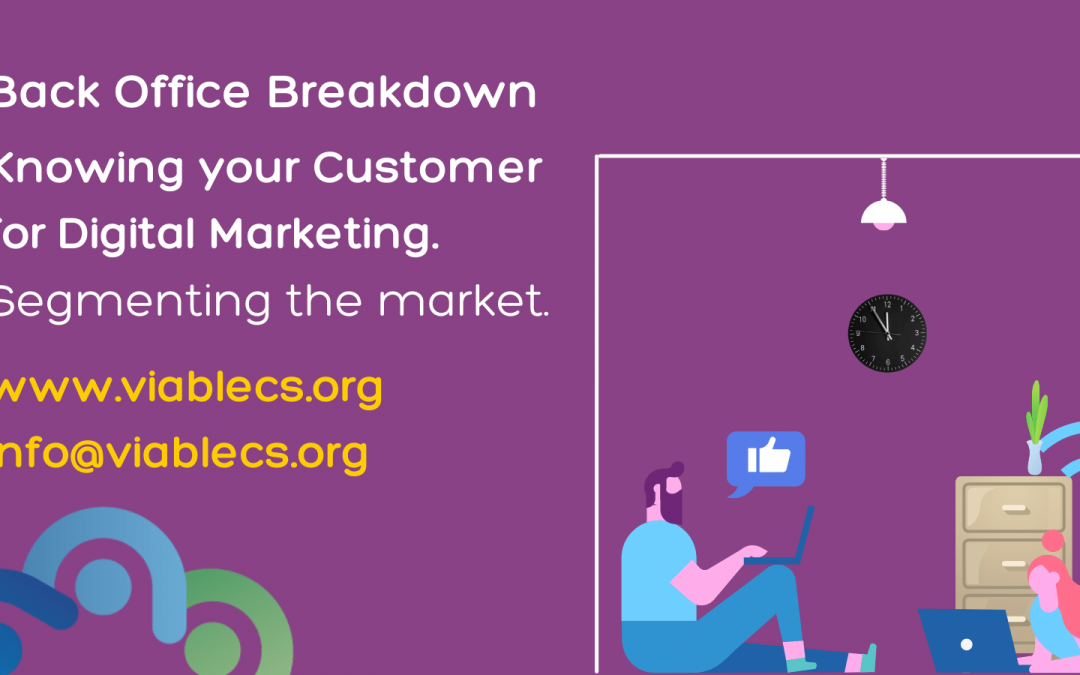Digital Marketing has been accelerating year-on-year, and since March 2020, that growth has seen unprecedented acceleration. Digital advertising has seen a massive increase in demand, with Google, Facebook, Alibaba, Bytedance and Amazon accounting for 46% of global advertising revenue in 2020.
Digital marketing encompasses all marketing efforts that use an electronic device or the internet.
Hubspot
Digital allows marketing functions to target their customer in new and creative ways, with tailored ads for certain audiences that you can set. Before leaping in to advertising, however, it’s important to identify who your consumer actually is?
Without knowing your customer, how can you know who to target with advertising? Yes, you could target everyone, but is that really an effective use of resources?
When identifying your customer, you must segment the market, identify target customers and profiles, and then position yourself around the needs of that customer.
Consider the following approach to segmentation, using past consumers, data and market analysis.
Segmentation: The 4 types of segmentation
When segmenting your market, you must consider the 4 types of segmentation:
- Demographics – age, gender, sex, job, family, parents
- Geographic – location, postcodes, regions, countries, cities
- Psychographic – interests, lifestyle, social class, personality type
- Behavioural – user status, benefits sought or wanted, loyalty and attitude
Some forms of segmentation for certain businesses may be more relevant- in strategy than others, but employing all 4 can give you a real understanding of who your customer truly is.
Example segmentation process
Consider in the case of Social Enterprises. In terms of psychographics, Social Enterprise consumers may be strongly passionate about social change, have a keen interest in charities and sustainability.
For your own organisation, you may use Google Analytics to track what age groups and gender mostly interact with your business’ website, giving you an indication of who engages with your business. For this example, let’s assume our business’ website has users primarily female aged between 25 and 34.
Geographically, statistic data from NISRA or the Census data from your relevant target market can provide great insights in to the demographic breakdowns across geographic areas. Using that data, you can determine population levels in certain areas, and pair that with your internal data to identify geographic targeting priorities. For this purpose, we’ll assume our customer is primarily located in the Belfast South area.
In terms of psychographics, you may look in to consumer insights data, using reports from Deloitte for example, who survey millennial and Generation Z Consumers about what matters to them. Considering our consumer in this scenario is between 25 and 34, we can surmise that they are a millennial consumer. Millennials will be active on different channels than Baby Boomers, and therefore this means our approach to reaching them must also change. Depending on our target demographic, our psychographic interests and behaviour will change. For Millennials, social change and impact, and a fight for sustainability and brands that have a clear, defined purpose is really important. Considering this, how can you shape your messaging to tailor toward that audience?
Behaviourally, you can then determine what benefits your consumer may want or need. Are they brand loyal? Do they want a quick solution with low involvement? Is their decision making process long and drawn out with a high level of commitment and involvement? These decision making processes will alter how you position your business going forward. Our business in this scenario produces ladies clothing with a Social Impact, providing a sustainable solution to fashion and contributing their profits back in to the community. The product is relatively low cost, and so has a low level of commitment, meaning a faster decision making process.
How do I use this information when Digital Marketing?
With our customer defined, you may consider taking this information to Social Advertising, or other Digital Advertising channels.
When setting up social media ads on Facebook, you’ll want to take the data you have on hand, and target that defined customer directly. Moreover, you may think about the ad design itself, and how that affects what way you create the posting.
Research shows that senses have a part to play, and the role of touch in advertising is quite important. For that reason, carousel ads where you can swipe between images can be really effective in driving engagement. Creating sleek visuals that reflect either your product or brand, and succinctly make clear what it is you are offering in a direct way is the key.
With clear positioning around what it is you are offering, a defined consumer through effective segmentation, and a strong ad design, you are ready to go.
For our example, we may input the following information:
Target female consumers aged between 25 and 34 in the Belfast area, who have interests in sustainability, fashion and social impact.
This may just be one target audience that we defined, and we may run multiple ads targeting different audiences. The key here is to make your audience narrow, but not too niche that you do not get the wide scope you need.
An audience that is too wide will likely target individuals who are not interested in what you are offering, and so you waste ad spend, driving down your return on ad-spend (ROAS) and eating in to marketing resources.
What should I be looking for?
With advertising, it is important to track performance as you go. It can be a bit of a trial and error process, testing what works for your business as you go. Moreover, certain businesses will perform better on certain social channels and advertising channels that others.
You want to ensure that your ad frequency is monitored, and when it reaches above 5, you may consider adapting your audiences if the ads are remaining ineffective in driving hot marketing qualified leads (MQLs) to your website destination or landing page.
You will also want to monitor conversion rates, and then start to measure the actual return on investment. For example, if a person clicks a pay per view ad that cost you £0.50 for the view, and you sold a t-shirt worth £8.99 to that consumer, then your return on ad spend is £17.98, meaning for every £1 you spend, you get £17.98 back.
You will never convert every view, but if you monitor your performance, adapt and change your approach, and ensure you keep your cost and return balanced, you will be on track for a successful ad campaign.
Need help setting up social media advertising for your business? Whilst we have covered a very foundational introduction, there are so many factors to consider when setting up ads on Social Media.
Our marketing experts can navigate that process for you, working with you to create sleek ads, identify your target consumer, and create campaigns on Social that convert. Learn more about our marketing services here on our website.
Alternatively, contact info@viablecs.org to set up an intro call, or call 028 9600 2317 to enquire directly with us today.



Recent Comments